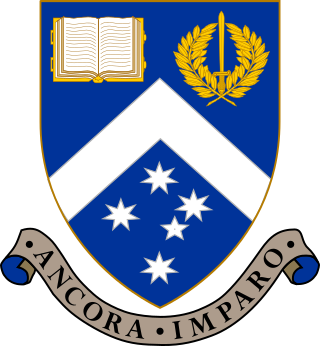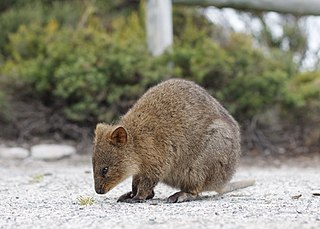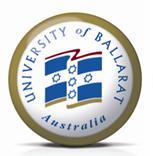Related Research Articles

The moose or elk is the only species in the genus Alces. The moose is the tallest and second-largest land mammal in North America, only falling short of the American buffalo in terms of mass. It is the largest and heaviest extant species of deer. Most adult male moose have distinctive broad, palmate antlers; most other members of the deer family have antlers with a dendritic ("twig-like") configuration. Moose typically inhabit boreal forests and temperate broadleaf and mixed forests of the Northern Hemisphere in temperate to subarctic climates. Hunting and other human activities have caused a reduction in the size of the moose's range over time. It has been reintroduced to some of its former habitats. Currently, most moose occur in Canada, Alaska, New England, New York State, Fennoscandia, the Baltic states, Poland, Kazakhstan, and Russia.
Technical and further education or simply TAFE is the common name in English-speaking countries in Oceania for vocational education, as a subset of tertiary education. TAFE institutions provide a wide range of predominantly vocational courses.

Victoria University is a public research university based in Melbourne, Victoria, Australia. It is a dual-sector university, providing courses in both higher education and technical and further education (TAFE).

Monash University is a public research university based in Melbourne, Victoria, Australia. Named after prominent World War I general Sir John Monash, it was founded in 1958 and is the second oldest university in the state. The university has a number of campuses, four of which are in Victoria, one in Malaysia and another one in Indonesia. Monash also has a research and teaching centre in Prato, Italy, a graduate research school in Mumbai, India and graduate schools in Suzhou, China and Tangerang, Indonesia. Monash University courses are also delivered at other locations, including South Africa.
La Trobe University is a public research university based in Melbourne, Victoria, Australia. Its main campus is located in the suburb of Bundoora. The university was established in 1964, becoming the third university in the state of Victoria and the twelfth university in Australia. La Trobe is one of the Australian verdant universities and also part of the Innovative Research Universities group.

Rottnest Island, often colloquially referred to as "Rotto", is a 19 km2 (7.3 sq mi) island off the coast of Western Australia, located 18 km (11 mi) west of Fremantle. A sandy, low-lying island formed on a base of aeolianite limestone, Rottnest is an A-class reserve, the highest level of protection afforded to public land.

The quokka is a small macropod about the size of a domestic cat. It is the only member of the genus Setonix. Like other marsupials in the macropod family, the quokka is herbivorous and mainly nocturnal.

Elk Island National Park is a national park in Alberta, Canada, that played an important part in the conservation of the Plains bison. The park is administered by the Parks Canada Agency. This "island of conservation" is 35 km (22 mi) east of Edmonton, along the Yellowhead Highway, which goes through the park. It is Canada's eighth smallest in area but largest fully enclosed national park, with an area of 194 km2 (75 sq mi).

Deakin University is a public university in Victoria, Australia. Founded in 1974, the university was named after Alfred Deakin, the second Prime Minister of Australia.

The sambar is a large deer native to the Indian subcontinent, South China and Southeast Asia that is listed as a vulnerable species on the IUCN Red List since 2008. Populations have declined substantially due to severe hunting, local insurgency, and industrial exploitation of habitat.

Sir John Quick was an Australian lawyer, politician and judge. He played a prominent role in the movement for Federation and the drafting of the Australian constitution, later writing several works on Australian constitutional law. He began his political career in the Victorian Legislative Assembly (1880–1889) and later won election to the House of Representatives at the first federal election in 1901. He served as Postmaster-General in the third Deakin Government (1909–1910). He lost his seat in 1913 and ended his public service as deputy president of the Commonwealth Court of Conciliation and Arbitration (1922–1930).

The University of Ballarat, Australia was a dual-sector university with multiple campuses in Victoria, Australia, including its main Ballarat campus, Melbourne, Sydney, and Adelaide that were authorized by the university to provide diploma, undergraduate and postgraduate programs. The university offered traditional programs, including business, information technology, building and construction, engineering, mining, education, social sciences, nursing, hospitality, and art.

Stonington is a private residence and former Australian Government House located in the Melbourne suburb of Malvern, at 336 Glenferrie Road. The house was built for John Wagner, a partner in Cobb and Co coaches. Stonington gave its name to the City of Stonnington, a Melbourne municipality.
Bald Island is an island that is located in the Great Southern region of Western Australia. The island is 1.5 kilometres (1 mi) offshore from Cheynes Beach and is a protected area managed by the Department of Parks and Wildlife.
Red foxes pose a serious conservation problem in Australia. 2012 estimates indicate that there are more than 7.2 million red foxes and growing with a range extending throughout most of the continental mainland. The species became established in Australia through successive introductions by settlers in 1830s. Due to its rapid spread and ecological impact it has classified as one of the most damaging invasive species in Australia.

Valerius Geist was a Canadian biologist and a professor emeritus in the Faculty of Environmental Design at the University of Calgary. He was a specialist on the biology, behavior, and social dynamics of North American large mammals, and well respected on his views of Neanderthal people and behavior.
Lindy Lumsden is a principal research scientist with the Department of Environment, Land, Water and Planning, at the Arthur Rylah Institute for Environmental Research, in Melbourne, Australia.
Nicole Rinehart is a Professor in Clinical Psychology, Director of the Deakin Child Study Centre (DCSC) and Director of Clinical and Community Partnerships at Deakin University. She established the Deakin Child Study Centre in 2013. She is located in Victoria, Australia.

The Department of Biodiversity, Conservation and Attractions (DBCA) is the Western Australian government department responsible for managing lands and waters described in the Conservation and Land Management Act 1984, the Rottnest Island Authority Act 1987, the Swan and Canning Rivers Management Act 2006, the Botanic Gardens and Parks Authority Act 1998, and the Zoological Parks Authority Act 2001, and implementing the state's conservation and environment legislation and regulations. The Department reports to the Minister for Environment and the Minister for Tourism.
Stephen Wickham is an Australian photographer, painter and printmaker.
References
- 1 2 Holsworth, WN (1964) Marsupial behaviour with special references to population homeostasis in the quokka on the West End of Rottnest Island. Ph.D. Thesis, Department of Zoology, University of Western Australia.
- 1 2 3 4 5 6 Joe Fennessy (2014) "25 years of giving" The Voice, 10(5): May 12-June 8, 2014. Retrieved 9 April 2016.
- 1 2 William N. Holsworth (1960) Interactions between moose, elk and buffalo in Elk Island National Park, Alberta MSc thesis, University of British Columbia.
- ↑ Hayley Sorensen (2015) "Bendigo couple make remarkable contribution" Bendigo Advertiser, 1 March 2015. Retrieved 10 April 2016.
- ↑ Danielle Clode (2006) "As If for a Thousand Years" Victorian Environmental Assessment Council: East Melbourne, Victoria. p71.
- ↑ Australian Mammal Society (2022). "Honorary Life Membership". australianmammals.org.au. Archived from the original on 29 January 2023. Retrieved 29 January 2023.
- 1 2 3 4 Stephanie Chenoweth (2008) "A solid base for your philanthropic dreams" The Australian, 4 June 2008. Retrieved 9 April 2016.
- ↑ "If you are planning for a lifetime, educate people" Deakin University. Accessed 9 April 2016.